Zhao Wang
AIM: Software and Hardware Co-design for Architecture-level IR-drop Mitigation in High-performance PIM
Nov 06, 2025Abstract:SRAM Processing-in-Memory (PIM) has emerged as the most promising implementation for high-performance PIM, delivering superior computing density, energy efficiency, and computational precision. However, the pursuit of higher performance necessitates more complex circuit designs and increased operating frequencies, which exacerbate IR-drop issues. Severe IR-drop can significantly degrade chip performance and even threaten reliability. Conventional circuit-level IR-drop mitigation methods, such as back-end optimizations, are resource-intensive and often compromise power, performance, and area (PPA). To address these challenges, we propose AIM, comprehensive software and hardware co-design for architecture-level IR-drop mitigation in high-performance PIM. Initially, leveraging the bit-serial and in-situ dataflow processing properties of PIM, we introduce Rtog and HR, which establish a direct correlation between PIM workloads and IR-drop. Building on this foundation, we propose LHR and WDS, enabling extensive exploration of architecture-level IR-drop mitigation while maintaining computational accuracy through software optimization. Subsequently, we develop IR-Booster, a dynamic adjustment mechanism that integrates software-level HR information with hardware-based IR-drop monitoring to adapt the V-f pairs of the PIM macro, achieving enhanced energy efficiency and performance. Finally, we propose the HR-aware task mapping method, bridging software and hardware designs to achieve optimal improvement. Post-layout simulation results on a 7nm 256-TOPS PIM chip demonstrate that AIM achieves up to 69.2% IR-drop mitigation, resulting in 2.29x energy efficiency improvement and 1.152x speedup.
SAMRI: Segment Anything Model for MRI
Oct 30, 2025Abstract:Accurate magnetic resonance imaging (MRI) segmentation is crucial for clinical decision-making, but remains labor-intensive when performed manually. Convolutional neural network (CNN)-based methods can be accurate and efficient, but often generalize poorly to MRI's variable contrast, intensity inhomogeneity, and protocols. Although the transformer-based Segment Anything Model (SAM) has demonstrated remarkable generalizability in natural images, existing adaptations often treat MRI as another imaging modality, overlooking these modality-specific challenges. We present SAMRI, an MRI-specialized SAM trained and validated on 1.1 million labeled MR slices spanning whole-body organs and pathologies. We demonstrate that SAM can be effectively adapted to MRI by simply fine-tuning its mask decoder using a two-stage strategy, reducing training time by 94% and trainable parameters by 96% versus full-model retraining. Across diverse MRI segmentation tasks, SAMRI achieves a mean Dice of 0.87, delivering state-of-the-art accuracy across anatomical regions and robust generalization on unseen structures, particularly small and clinically important structures.
CoAR: Concept Injection into Autoregressive Models for Personalized Text-to-Image Generation
Aug 10, 2025



Abstract:The unified autoregressive (AR) model excels at multimodal understanding and generation, but its potential for customized image generation remains underexplored. Existing customized generation methods rely on full fine-tuning or adapters, making them costly and prone to overfitting or catastrophic forgetting. In this paper, we propose \textbf{CoAR}, a novel framework for injecting subject concepts into the unified AR models while keeping all pre-trained parameters completely frozen. CoAR learns effective, specific subject representations with only a minimal number of parameters using a Layerwise Multimodal Context Learning strategy. To address overfitting and language drift, we further introduce regularization that preserves the pre-trained distribution and anchors context tokens to improve subject fidelity and re-contextualization. Additionally, CoAR supports training-free subject customization in a user-provided style. Experiments demonstrate that CoAR achieves superior performance on both subject-driven personalization and style personalization, while delivering significant gains in computational and memory efficiency. Notably, CoAR tunes less than \textbf{0.05\%} of the parameters while achieving competitive performance compared to recent Proxy-Tuning. Code: https://github.com/KZF-kzf/CoAR
OMS: On-the-fly, Multi-Objective, Self-Reflective Ad Keyword Generation via LLM Agent
Jul 03, 2025Abstract:Keyword decision in Sponsored Search Advertising is critical to the success of ad campaigns. While LLM-based methods offer automated keyword generation, they face three major limitations: reliance on large-scale query-keyword pair data, lack of online multi-objective performance monitoring and optimization, and weak quality control in keyword selection. These issues hinder the agentic use of LLMs in fully automating keyword decisions by monitoring and reasoning over key performance indicators such as impressions, clicks, conversions, and CTA effectiveness. To overcome these challenges, we propose OMS, a keyword generation framework that is On-the-fly (requires no training data, monitors online performance, and adapts accordingly), Multi-objective (employs agentic reasoning to optimize keywords based on multiple performance metrics), and Self-reflective (agentically evaluates keyword quality). Experiments on benchmarks and real-world ad campaigns show that OMS outperforms existing methods; ablation and human evaluations confirm the effectiveness of each component and the quality of generated keywords.
DyST-XL: Dynamic Layout Planning and Content Control for Compositional Text-to-Video Generation
Apr 21, 2025



Abstract:Compositional text-to-video generation, which requires synthesizing dynamic scenes with multiple interacting entities and precise spatial-temporal relationships, remains a critical challenge for diffusion-based models. Existing methods struggle with layout discontinuity, entity identity drift, and implausible interaction dynamics due to unconstrained cross-attention mechanisms and inadequate physics-aware reasoning. To address these limitations, we propose DyST-XL, a \textbf{training-free} framework that enhances off-the-shelf text-to-video models (e.g., CogVideoX-5B) through frame-aware control. DyST-XL integrates three key innovations: (1) A Dynamic Layout Planner that leverages large language models (LLMs) to parse input prompts into entity-attribute graphs and generates physics-aware keyframe layouts, with intermediate frames interpolated via trajectory optimization; (2) A Dual-Prompt Controlled Attention Mechanism that enforces localized text-video alignment through frame-aware attention masking, achieving the precise control over individual entities; and (3) An Entity-Consistency Constraint strategy that propagates first-frame feature embeddings to subsequent frames during denoising, preserving object identity without manual annotation. Experiments demonstrate that DyST-XL excels in compositional text-to-video generation, significantly improving performance on complex prompts and bridging a crucial gap in training-free video synthesis.
DreamFuse: Adaptive Image Fusion with Diffusion Transformer
Apr 11, 2025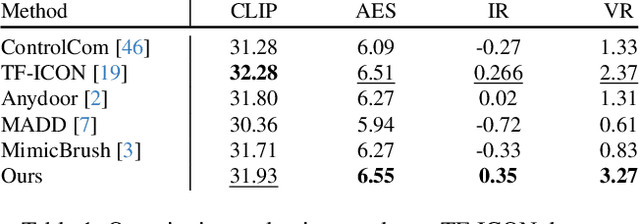
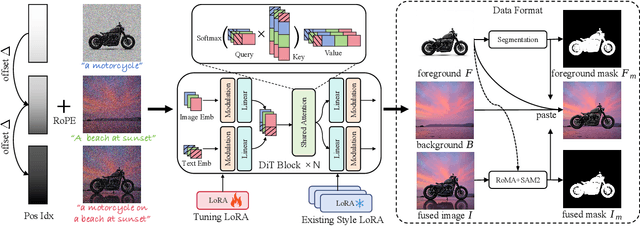


Abstract:Image fusion seeks to seamlessly integrate foreground objects with background scenes, producing realistic and harmonious fused images. Unlike existing methods that directly insert objects into the background, adaptive and interactive fusion remains a challenging yet appealing task. It requires the foreground to adjust or interact with the background context, enabling more coherent integration. To address this, we propose an iterative human-in-the-loop data generation pipeline, which leverages limited initial data with diverse textual prompts to generate fusion datasets across various scenarios and interactions, including placement, holding, wearing, and style transfer. Building on this, we introduce DreamFuse, a novel approach based on the Diffusion Transformer (DiT) model, to generate consistent and harmonious fused images with both foreground and background information. DreamFuse employs a Positional Affine mechanism to inject the size and position of the foreground into the background, enabling effective foreground-background interaction through shared attention. Furthermore, we apply Localized Direct Preference Optimization guided by human feedback to refine DreamFuse, enhancing background consistency and foreground harmony. DreamFuse achieves harmonious fusion while generalizing to text-driven attribute editing of the fused results. Experimental results demonstrate that our method outperforms state-of-the-art approaches across multiple metrics.
DreamLayer: Simultaneous Multi-Layer Generation via Diffusion Mode
Mar 17, 2025



Abstract:Text-driven image generation using diffusion models has recently gained significant attention. To enable more flexible image manipulation and editing, recent research has expanded from single image generation to transparent layer generation and multi-layer compositions. However, existing approaches often fail to provide a thorough exploration of multi-layer structures, leading to inconsistent inter-layer interactions, such as occlusion relationships, spatial layout, and shadowing. In this paper, we introduce DreamLayer, a novel framework that enables coherent text-driven generation of multiple image layers, by explicitly modeling the relationship between transparent foreground and background layers. DreamLayer incorporates three key components, i.e., Context-Aware Cross-Attention (CACA) for global-local information exchange, Layer-Shared Self-Attention (LSSA) for establishing robust inter-layer connections, and Information Retained Harmonization (IRH) for refining fusion details at the latent level. By leveraging a coherent full-image context, DreamLayer builds inter-layer connections through attention mechanisms and applies a harmonization step to achieve seamless layer fusion. To facilitate research in multi-layer generation, we construct a high-quality, diverse multi-layer dataset including 400k samples. Extensive experiments and user studies demonstrate that DreamLayer generates more coherent and well-aligned layers, with broad applicability, including latent-space image editing and image-to-layer decomposition.
Unlocking Pretrained LLMs for Motion-Related Multimodal Generation: A Fine-Tuning Approach to Unify Diffusion and Next-Token Prediction
Mar 08, 2025Abstract:In this paper, we propose a unified framework that leverages a single pretrained LLM for Motion-related Multimodal Generation, referred to as MoMug. MoMug integrates diffusion-based continuous motion generation with the model's inherent autoregressive discrete text prediction capabilities by fine-tuning a pretrained LLM. This enables seamless switching between continuous motion output and discrete text token prediction within a single model architecture, effectively combining the strengths of both diffusion- and LLM-based approaches. Experimental results show that, compared to the most recent LLM-based baseline, MoMug improves FID by 38% and mean accuracy across seven metrics by 16.61% on the text-to-motion task. Additionally, it improves mean accuracy across eight metrics by 8.44% on the text-to-motion task. To the best of our knowledge, this is the first approach to integrate diffusion- and LLM-based generation within a single model for motion-related multimodal tasks while maintaining low training costs. This establishes a foundation for future advancements in motion-related generation, paving the way for high-quality yet cost-efficient motion synthesis.
Seeing is Understanding: Unlocking Causal Attention into Modality-Mutual Attention for Multimodal LLMs
Mar 04, 2025Abstract:Recent Multimodal Large Language Models (MLLMs) have demonstrated significant progress in perceiving and reasoning over multimodal inquiries, ushering in a new research era for foundation models. However, vision-language misalignment in MLLMs has emerged as a critical challenge, where the textual responses generated by these models are not factually aligned with the given text-image inputs. Existing efforts to address vision-language misalignment have focused on developing specialized vision-language connectors or leveraging visual instruction tuning from diverse domains. In this paper, we tackle this issue from a fundamental yet unexplored perspective by revisiting the core architecture of MLLMs. Most MLLMs are typically built on decoder-only LLMs consisting of a causal attention mechanism, which limits the ability of earlier modalities (e.g., images) to incorporate information from later modalities (e.g., text). To address this problem, we propose AKI, a novel MLLM that unlocks causal attention into modality-mutual attention (MMA) to enable image tokens to attend to text tokens. This simple yet effective design allows AKI to achieve superior performance in 12 multimodal understanding benchmarks (+7.2% on average) without introducing additional parameters and increasing training time. Our MMA design is intended to be generic, allowing for application across various modalities, and scalable to accommodate diverse multimodal scenarios. The code is publicly available at https://github.com/sony/aki, and we will release our AKI-4B model to encourage further advancements in MLLMs across various directions.
Large Images are Gaussians: High-Quality Large Image Representation with Levels of 2D Gaussian Splatting
Feb 13, 2025
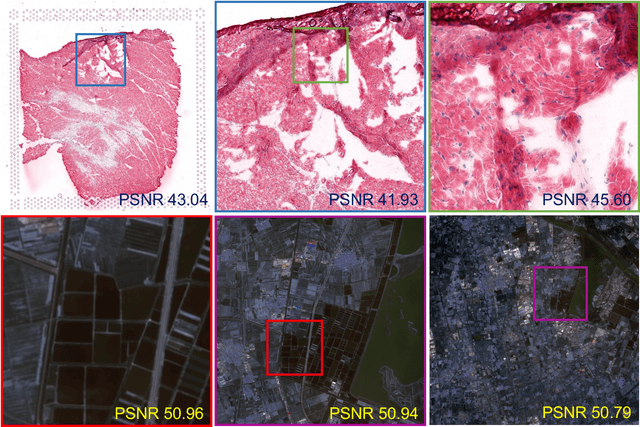
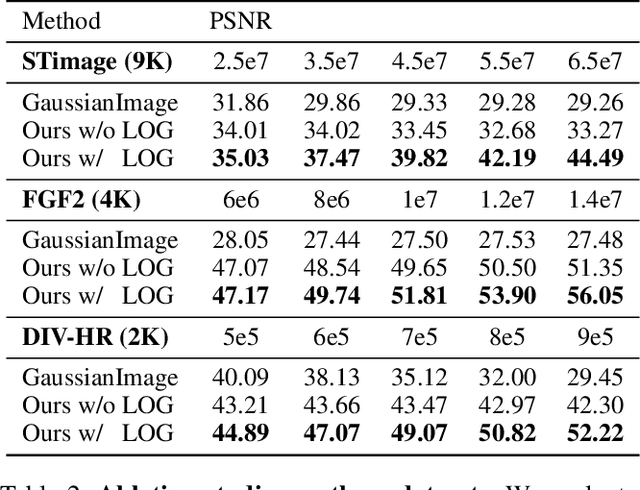
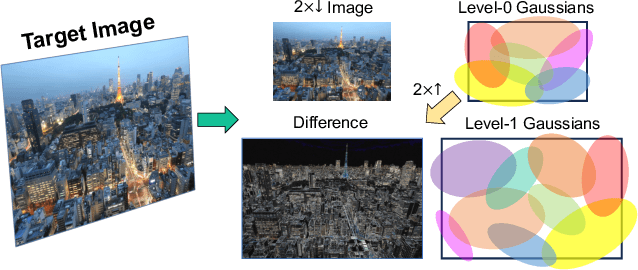
Abstract:While Implicit Neural Representations (INRs) have demonstrated significant success in image representation, they are often hindered by large training memory and slow decoding speed. Recently, Gaussian Splatting (GS) has emerged as a promising solution in 3D reconstruction due to its high-quality novel view synthesis and rapid rendering capabilities, positioning it as a valuable tool for a broad spectrum of applications. In particular, a GS-based representation, 2DGS, has shown potential for image fitting. In our work, we present \textbf{L}arge \textbf{I}mages are \textbf{G}aussians (\textbf{LIG}), which delves deeper into the application of 2DGS for image representations, addressing the challenge of fitting large images with 2DGS in the situation of numerous Gaussian points, through two distinct modifications: 1) we adopt a variant of representation and optimization strategy, facilitating the fitting of a large number of Gaussian points; 2) we propose a Level-of-Gaussian approach for reconstructing both coarse low-frequency initialization and fine high-frequency details. Consequently, we successfully represent large images as Gaussian points and achieve high-quality large image representation, demonstrating its efficacy across various types of large images. Code is available at {\href{https://github.com/HKU-MedAI/LIG}{https://github.com/HKU-MedAI/LIG}}.
 Add to Chrome
Add to Chrome Add to Firefox
Add to Firefox Add to Edge
Add to Edge